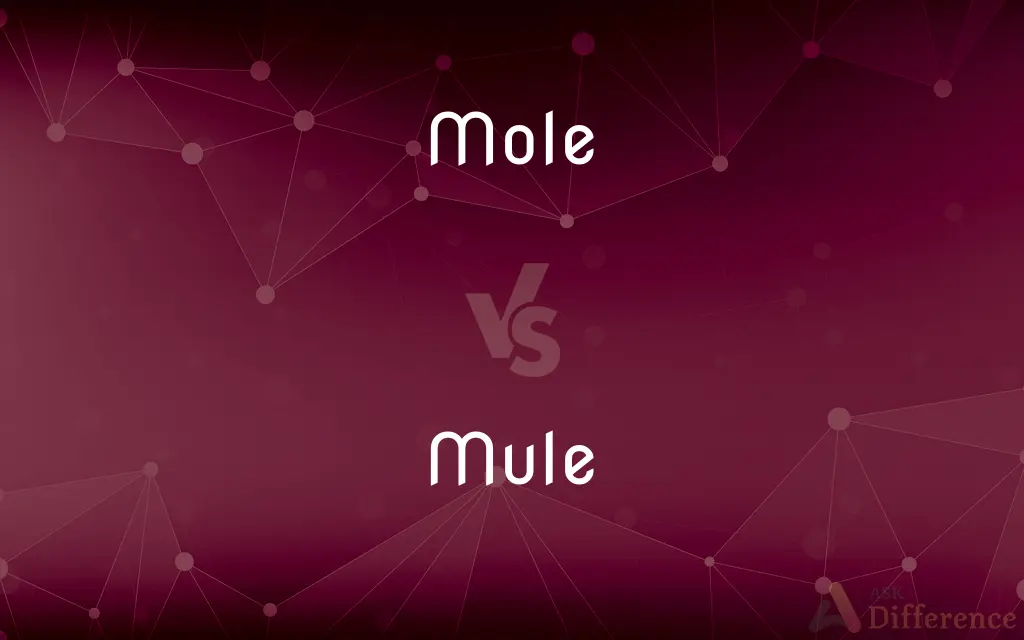Mole vs. Mule — What's the Difference?
Edited by Tayyaba Rehman — By Fiza Rafique — Updated on April 5, 2024
A mole is a small, burrowing mammal with velvety fur and poor eyesight, known for living underground; a mule is a hybrid animal, offspring of a male donkey and a female horse, valued for its strength and endurance.

Difference Between Mole and Mule
Table of Contents
ADVERTISEMENT
Key Differences
Moles are small, insectivorous mammals characterized by their velvety fur, small eyes, and powerful digging claws, primarily living underground and rarely seen above ground. On the other hand, mules are domesticated hybrid animals resulting from the crossbreeding of a male donkey (jack) with a female horse (mare), known for their hardiness, strength, and larger size compared to donkeys.
While moles spend most of their lives in solitude, tunneling underground in search of insects and earthworms, mules are often used by humans for transport, agricultural work, and as pack animals due to their endurance and ability to carry heavy loads. Whereas moles have specialized physical adaptations for a subterranean lifestyle, such as a cylindrical body and reduced eyesight, mules inherit characteristics from both parents, including the horse's size and speed and the donkey's patience and durability.
Moles have a significant impact on soil health and aeration through their tunneling activities, despite sometimes being considered pests in gardens and lawns for the surface disturbances they cause. In contrast, mules contribute to human economies, especially in agriculture and transport, offering a sustainable and efficient means of labor in various environments.
Moles are solitary by nature and have a specific breeding season, usually once a year, while mules are sterile and cannot reproduce, a common trait among hybrids. This sterility of mules underscores the biological implications of cross-species breeding, focusing on the practical benefits of hybrid vigor without the continuation of hybrid lines through reproduction.
The life span of a mole in the wild is relatively short, typically 3 to 5 years, due to natural predators and environmental factors. Conversely, mules enjoy a longer lifespan, often living more than 20 years, benefiting from human care and lack of natural predators in domestic settings.
ADVERTISEMENT
Comparison Chart
Type
Mammal
Hybrid animal
Habitat
Underground, solitary
Domesticated, used for work and transport
Diet
Insectivorous
Herbivorous
Physical Traits
Velvety fur, small eyes, powerful digging claws
Inherits traits from both horse and donkey
Use by Humans
Considered pests in some contexts
Used for transport, agricultural work, and as pack animals
Reproduction
Breeds once a year, solitary
Sterile, cannot reproduce
Lifespan
3-5 years in the wild
Often more than 20 years with human care
Impact
Soil aeration and health, sometimes garden pests
Economic contribution in agriculture and transport
Compare with Definitions
Mole
A small, burrowing mammal with velvety fur, known for its subterranean lifestyle.
The garden was full of molehills, a clear sign of a mole's presence.
Mule
Known for its endurance and ability to carry heavy loads.
Mules are invaluable in mountainous regions for transporting goods.
Mole
Lives a solitary life, rarely seen above ground.
Despite its busy tunneling activity, the mole seldom emerges into the daylight.
Mule
Inherits the size and speed of a horse and the patience of a donkey.
The mule combines the best traits of its parents, making it a reliable working animal.
Mole
Primarily feeds on insects and worms, contributing to soil health.
Moles play a crucial role in aerating the soil and controlling insect populations.
Mule
A hybrid animal born from a male donkey and a female horse, used for work.
The farmer preferred using mules for plowing the steep fields.
Mole
Has poor eyesight and relies on its sense of touch.
The mole's small eyes are nearly useless; it navigates underground through touch.
Mule
Sterile and cannot reproduce, highlighting hybrid vigor.
Although mules cannot have offspring, they are prized for their strength and temperament.
Mole
Known for creating extensive tunnel networks.
A mole can dig tunnel systems extending for hundreds of yards.
Mule
Valued in agriculture and transport for its hardiness.
Mules have been a crucial part of agricultural practices for centuries.
Mole
To form holes in, as a mole; to burrow; to excavate; as, to mole the earth.
Mule
A mule is the offspring of a male donkey (jack) and a female horse (mare). Horses and donkeys are different species, with different numbers of chromosomes.
Mole
To clear of molehills.
Mule
The sterile hybrid offspring of a male donkey and a female horse, characterized by long ears and a short mane.
Mole
A small burrowing mammal with dark velvety fur, a long muzzle, and very small eyes, feeding mainly on worms, grubs, and other invertebrates.
Mule
A sterile hybrid, as between a canary and other birds or between certain plants.
Mole
A spy who gradually achieves an important position within the security defences of a country
A well-placed mole was feeding them the names of operatives
Mule
(Informal) A stubborn person.
Mole
A small, often slightly raised blemish on the skin made dark by a high concentration of melanin
A mole on her arm had not been there at the beginning of the summer
Mule
A spinning machine that makes thread or yarn from fibers. Also called spinning mule.
Mole
A large solid structure on a shore serving as a pier, breakwater, or causeway.
Mule
A small, usually electric tractor or locomotive used for hauling over short distances.
Mole
The SI unit of amount of substance, equal to the quantity containing as many elementary units as there are atoms in 0.012 kg of carbon-12.
Mule
(Slang) A person who serves as a courier of illegal drugs.
Mole
An abnormal mass of tissue in the uterus.
Mule
A backless slipper or shoe, often with a closed toe.
Mole
A highly spiced Mexican sauce made chiefly from chilli peppers and chocolate, served with meat.
Mule
The generally sterile male or female hybrid offspring of a male donkey and a female horse.
Mole
A skin lesion, commonly a nevus, that is typically raised and discolored.
Mule
The generally sterile hybrid offspring of any two species of animals.
Mole
Any of various small insectivorous mammals of the family Talpidae of North America and Eurasia, usually living underground and having a thickset body with light brown to dark gray silky fur, strong forefeet for burrowing, and often rudimentary eyes.
Mule
A hybrid plant.
Mole
A machine that bores through hard surfaces, used especially for tunneling through rock.
Mule
(informal) A stubborn person.
Mole
A spy who operates from within an organization, especially a double agent operating against that agent's own government from within its intelligence establishment.
Mule
(slang) A person paid to smuggle drugs.
Mole
A massive, usually stone wall constructed in the sea, used as a breakwater and built to enclose or protect an anchorage or a harbor.
Mule
A coin or medal minted with obverse and reverse designs not normally seen on the same piece, either intentionally or in error.
Mole
The anchorage or harbor enclosed by a mole.
Mule
(RPG) A MMORPG character, or NPC companion in a tabletop RPG, used mainly to store extra inventory for the owner's primary character.
Mole
A fleshy abnormal mass formed in the uterus by the degeneration or abortive development of an ovum.
Mule
Any of a group of cocktails involving ginger ale or ginger beer, citrus juice, and various liquors.
Mole
In the International System, the base unit used in representing an amount of a substance, equal to the amount of that substance that contains as many atoms, molecules, ions, or other elementary units as the number of atoms in 0.012 kilogram of carbon-12. The number is 6.0221 × 1023, or Avogadro's number. See Table at measurement.
Mule
(sailing) A kind of triangular sail for a yacht.
Mole
A pigmented spot on the skin, a naevus, slightly raised, and sometimes hairy.
Mule
A kind of cotton-spinning machine.
Mole
Any of several small, burrowing insectivores of the family Talpidae; also any of southern African mammals in the family Chrysochloridae (golden moles) and any of several Australian mammals in the family Notoryctidae (marsupial moles), similar to but not closely related to Talpidae moles
Mule
A shoe that has no fitting or strap around the heel, but which covers the foot.
Mole
Any of the burrowing rodents also called mole-rats.
Mule
To smuggle (illegal drugs).
Mole
(espionage) An internal spy, a person who involves himself or herself with an enemy organisation, especially an intelligence or governmental organisation, to determine and betray its secrets from within.
Mule
A hybrid animal; specifically, one generated between an ass and a mare. Sometimes the term is applied to the offspring of a horse and a she-ass, but that hybrid is more properly termed a hinny. See Hinny.
Mole
A kind of self-propelled excavator used to form underground drains, or to clear underground pipelines
Mule
A plant or vegetable produced by impregnating the pistil of one species with the pollen or fecundating dust of another; - called also hybrid.
Mole
A type of underground drain used in farm fields, in which a mole plow creates an unlined channel through clay subsoil.
Mule
A very stubborn person.
Mole
A moll, a bitch, a slut.
Mule
A machine, used in factories, for spinning cotton, wool, etc., into yarn or thread and winding it into cops; - called also jenny and mule-jenny.
Mole
(nautical) A massive structure, usually of stone, used as a pier, breakwater or junction between places separated by water.
Mule
A slipper that has no fitting around the heel.
Mole
(rare) A haven or harbour, protected with such a breakwater.
Mule
Sterile offspring of a male donkey and a female horse
Mole
(historical) An Ancient Roman mausoleum.
Mule
A slipper that has no fitting around the heel
Mole
In the International System of Units, the base unit of amount of substance; the amount of substance of a system which contains exactly 6.02214076×1023 elementary entities (atoms, ions, molecules, etc.). Symbol: mol. The number of atoms is known as Avogadro’s number. from 1897
Mole
One of several spicy sauces typical of the cuisine of Mexico and neighboring Central America, especially a sauce which contains chocolate and which is used in cooking main dishes, not desserts.
Mole
A spot; a stain; a mark which discolors or disfigures.
Mole
A spot, mark, or small permanent protuberance on the human body; esp., a spot which is dark-colored, from which commonly issue one or more hairs.
Mole
A mass of fleshy or other more or less solid matter generated in the uterus.
Mole
A mound or massive work formed of masonry or large stones, etc., laid in the sea, often extended either in a right line or an arc of a circle before a port which it serves to defend from the violence of the waves, thus protecting ships in a harbor; also, sometimes, the harbor itself.
Mole
Any insectivore of the family Talpidæ. They have minute eyes and ears, soft fur, and very large and strong fore feet.
Mole
A plow of peculiar construction, for forming underground drains.
Mole
A spy who lives for years an apparently normal life (to establish a cover) before beginning his spying activities.
Mole
A quantity of a substance equal to the molecular weight of a substance expressed in grams; a gram molecule; the basic unit of amount of substance adopted under the System International d'Unites; as, he added two moles of sodium chloride to the medium.
Mole
The molecular weight of a substance expressed in grams; the basic unit of amount of substance adopted under the Systeme International d'Unites
Mole
A spy who works against enemy espionage
Mole
Spicy sauce often containing chocolate
Mole
A small congenital pigmented spot on the skin
Mole
A protective structure of stone or concrete; extends from shore into the water to prevent a beach from washing away
Mole
Small velvety-furred burrowing mammal having small eyes and fossorial forefeet
Common Curiosities
Do moles have any benefits to the environment?
Yes, moles contribute to soil aeration and health by tunneling, which can improve water infiltration and nutrient mixing.
What is the main difference between a mole and a mule?
A mole is a small burrowing mammal, while a mule is a hybrid animal created by breeding a male donkey with a female horse.
Are mules stronger than horses?
Mules inherit the hardiness and endurance of donkeys and the strength of horses, making them very strong, especially for certain tasks.
Can mules reproduce?
No, mules are sterile and cannot reproduce.
Why are moles considered pests?
Moles are often considered pests because their tunneling can disturb lawns and gardens, creating unsightly molehills.
How long do moles live?
Moles typically live for 3 to 5 years in the wild.
What is the lifespan of a mule?
Mules often live more than 20 years, especially with proper care from humans.
What are mules used for?
Mules are used for transport, agricultural work, and as pack animals due to their strength and endurance.
How do moles navigate underground?
Moles navigate primarily through their sense of touch, as they have poor eyesight.
Do mules have a specific diet?
Like horses and donkeys, mules are herbivorous and typically feed on a variety of plant material.
Can moles see?
Moles have very poor eyesight and rely mostly on their sense of touch and hearing to navigate and find food.
How do moles benefit from living underground?
Living underground protects moles from predators and allows them to access a constant supply of their food sources, like insects and worms.
Why are mules sterile?
Mules are sterile due to the genetic differences between their parents (donkeys and horses), which result in an odd number of chromosomes that cannot pair up properly to produce fertile gametes.
What makes mules valuable in mountainous regions?
Their strength, endurance, and ability to navigate difficult terrain make mules valuable for carrying loads in mountainous regions.
What characteristics do mules inherit from donkeys?
Mules inherit the patience, durability, and endurance of donkeys, making them suitable for various types of work and environments.
Share Your Discovery

Previous Comparison
Backbiting vs. Gossiping
Next Comparison
Eruption vs. IrruptionAuthor Spotlight
Written by
Fiza RafiqueFiza Rafique is a skilled content writer at AskDifference.com, where she meticulously refines and enhances written pieces. Drawing from her vast editorial expertise, Fiza ensures clarity, accuracy, and precision in every article. Passionate about language, she continually seeks to elevate the quality of content for readers worldwide.
Edited by
Tayyaba RehmanTayyaba Rehman is a distinguished writer, currently serving as a primary contributor to askdifference.com. As a researcher in semantics and etymology, Tayyaba's passion for the complexity of languages and their distinctions has found a perfect home on the platform. Tayyaba delves into the intricacies of language, distinguishing between commonly confused words and phrases, thereby providing clarity for readers worldwide.
















































